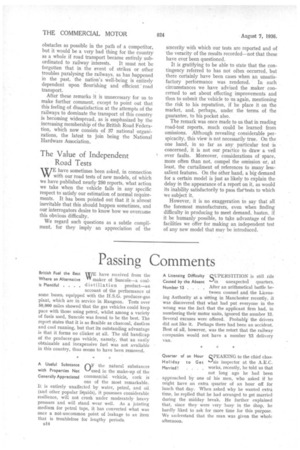Passing Comments
Page 24

Page 25

If you've noticed an error in this article please click here to report it so we can fix it.
British Fuel the Best WE have received from the Where an Alternative " maker of Suncole—a coal
is Plentiful . . . . distillation product—an account of the performance of some buses; equipped with the H.S.G. producer-gas plant, which are in service in Rangoon. Tests over 50,000 miles showed that the gas vehicles could keep pace with those using petrol, whilst among a variety of fuels used, Suncole was found to be the best. The report states that it is as flexible as charcoal, dustless and cool running, but that its outstanding advantage is that it forms no clinker at all. The old handicap of the producer-gas vehicle, namely, that an easily obtainable and inexpensive fuel was not available in this country, thus seems to have been removed.
A Useful Substance rv., the natural substances with Properties Not used in the make-up of the Generally Appreciated commercial vehicle, cork is
one of the most remarkable. It is entirely unaffected by water, petrol, and oil (and other popular liquids), it possesses considerable resilience, will not crush under moderately heavy pressure and will stand wear well. As a jointing medium for petrol taps, it has converted what was once a not-uncommon point of leakage to an item that is troublefree for lengthy periods.
814
SLTPERSTITION is still rife in unexpected quarters. After an arithmetical battle between counsel and the Licensing Authority at a sitting in Manchester recently, it was discovered that what had put everyone in the wrong was the fact that the applicant firm had, in numbering their motor units, ignored the number 13. Several excuses were offered. Probably the drivers did not like it. Perhaps there had been an accident. Best of all, however, was the retort that the railway companies would not have a number 13 delivery van. A Licensing Difficulty Caused by the Absent
Number 13 . .
Quarter of an Hour QPEAKING to the chief chas Holl day to Get inspector at the A.E.C.
Married! . . works, recently, he told us that
not long ago he had been approached by one of his men, who asked if he might have an extra quarter of an hour off for lunch that day. When asked why he wanted extra time, he replied that he had arranged to get married during the midday break. He further explained that, since they were very busy in the shop, he hardly liked to ask for more time for this purpose. We understand that the man was given the whole afternoon.
Oil Engines Sometimes WITH some oil-engined Necessitate Bigger vv vehicles it has been found Front Tyres . . . . that the tyres fitted• to the•
front wheels wear more rapidly because of the additional weight of the engine compared with the petrol type, and in some instances it may be advisable to fit larger sizes when replacements are being made.
Rhodesia Developing pto HODESIA is making conTrackways as Efficient " siderable use of trackways
Thoroughfare . , as a cheap and excellent form of road. Each of the two tracks is about 18 ins, wide, and filled with tarmac to a depth of from 3 ins. to 6 ins. One length from Bulawayo to Salisbury, a distance of 288 miles, will be completed by September. A native is appointed to each eight miles of this ' road," his task being to keep the earth part level with the tracks. The law of passing is that each vehicle shall have its oil-side wheels on its near-side track.
On New and Old IT does not always do to rely Vehicles Check Front 'upon, the front wheels of a
Tracking new vehicle as being correctly tracked. Cases of excessive tyre wear which have reduced the life from, say, 60,000 miles to 20,000 miles have been traced to this cause, and it may prove a serious item where costs have to be watched very closely.
THE Trans-Canada motor highway extending for over 3,000 miles from Cape Breton Island in the Atlantic to Vancouver, British Columbia, is nearing completion. Three links are still required, but in only one casein the Rocky Mountain district—is the road still quite impassable to motor vehicles. In the other two cases, roads exist, but are primitive. It will still take three to four years to complete the route at a cost of about 20,000,000 dollars. This highway will open up vast stretches of new territory for industrial development. A 3,000-mile Canadian Highway Approaching
Completion




















































































